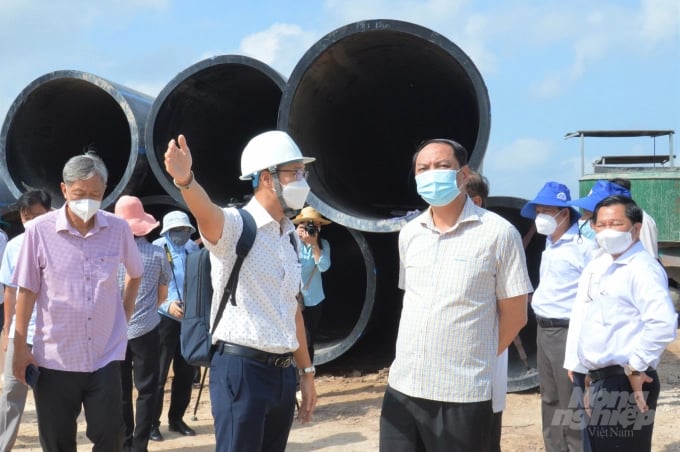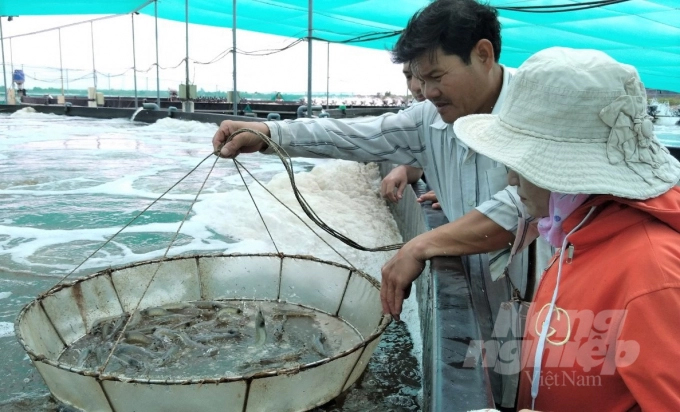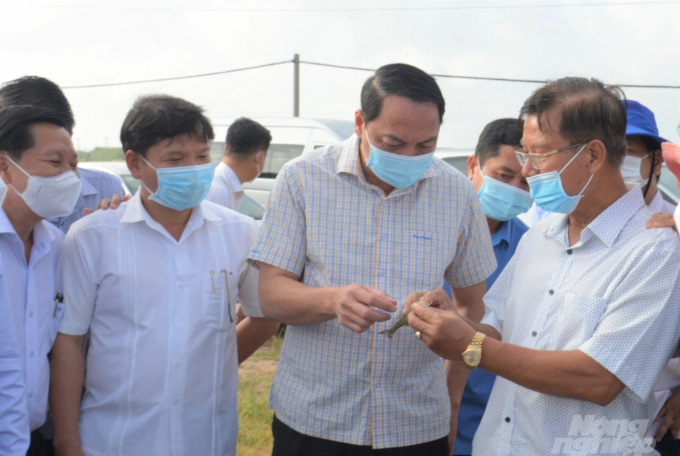November 28, 2025 | 06:02 GMT +7
November 28, 2025 | 06:02 GMT +7
Hotline: 0913.378.918
November 28, 2025 | 06:02 GMT +7
Hotline: 0913.378.918

Chairman of the People's Committee of Kien Giang province Lam Minh Thanh (3rd from left) inspects the implementation of the pipeline system to collect sea water for hi-tech shrimp farming of Minh Phu Hi-tech Agriculture Joint Stock Company at the starting point at Cha Va beach, Duong Hoa commune, Kien Luong district. Photo: Trung Chanh.
The underground pipeline system is invested by Minh Phu Hi-tech Agriculture Joint Stock Company and is being constructed in Kien Luong district, Kien Giang province.
When completed, this will be the first giant underground pipeline in the Mekong Delta. The pipeline has a diameter that an adult can walk through, a length of kilometers to take in offshore, clean, and high salinity sea water for industrial intensive shrimp farming with hi-tech applications.
The total area of brackish water shrimp farming that this underground pipeline system can serve is 9,338 hectares, of the hi-tech agricultural area in Kien Giang province stretching across 3 districts and cities of Ha Tien, Kien Luong and Giang Thanh.
According to the plan, this project of underground sea water pipeline system for shrimp farming will be constructed from now to 2025, divided into two phases.

Investing in infrastructure systems, especially water supply and drainage systems, will help industrial brackish water shrimp farming in the Long Xuyen Quadrangle develop effectively and sustainably. Photo: Trung Chanh.
Phase 1 has 2 pipelines systems.
The pipeline No. V, with a water supply capacity of 600 - 900 hectares, has a pumping station with a 1,600mm in diameter pipeline to take sea water 1,000 - 1,500 m far from the shore. The push pipe is 6.8 - 9 km in length, 1,400mm in diameter, and is capable of supplying sea water for shrimp farming for an area of 600 - 900 hectares in Duong Hoa commune, Kien Luong district.
The Cay Me canal pipeline will improve water supply capacity for 3,100 hectares. Being constructed on Cay Me canal, ít has a pumping station and an offshore water pipeline with capacity to supply water for an additional of 3,100 hectares in Bai Ot hamlet, Duong Hoa commune, Kien Luong district.
In phase 2, the water supply capacity of whole system is increased by 5,838 hectares, up to 9,838 hectares. A pumping station and a pipeline system to take sea water will be constructed at Cay Bang junction. There will have an investment in dredging the water supply canal along Cay Bang route and the works on the canal will be able to supply water for 5,838 hectares more, in Rach Nui hamlet, Thuan Yen commune, Ha Tien city.

In order for the brackish water shrimp industry to develop in a sustainable way, first of all, it is necessary to focus on investing in the infrastructure of the farming area, with a separate water supply and drainage system. Photo: Trung Chanh.
In the report proposing the project implementation, Nguyen Van Dung, Director of Kien Giang Department of Agriculture and Rural Development, assessed: The deployment of an underground pipeline system to collect clean and high salinity sea water is very necessary. The system will contribute to the sustainable development of industrial shrimp farming, especially high-tech shrimp farming in the Long Xuyen Quadrangle in the near future.
Total investment is expected to be VND 2,819 billion, raised from the operating capital of Minh Phu Hi-tech Agriculture Joint Stock Company. In phase 1, the investment for pipeline No. V is VND 386 billion, for Cay Me canal is VND 633 billion. In phase 2, the investment is VND 1,800 billion. Both phases of the project is expected to be completed by the end of June 2025.
Quang Trong Thao, Deputy Director of Kien Giang Department of Agriculture and Rural Development, said that in 2022, the province plans to develop brackish shrimp farming with a total area of 140,630 hectares, with a harvest of 108,500 tons of commercial shrimp. In which, the area of industrial and semi-industrial intensive shrimp farming is 4,200 hectares, with an output of 39,250 tons, extensive shrimp-rice farming with an area of 107,60 hectares with an output of 58,000 tons and an improved extensive shrimp farming area of 28,830 hectares, output is 11,250 tons.
Speaking at the conference to promote sustainable agricultural development in the Mekong Delta, held in Kien Giang on March 6, Le Van Quang, General Director of Minh Phu Seafood Group, said that in order to develop the shrimp industry in the Mekong Delta, we need to integrate regional and inter-regional infrastructure development planning, in which focusing on shrimp farming infrastructure, especially the segregation of the two systems of water supply and drainage is very important.
Taking the example of Ecuador, Quang said that the shrimp farming area of this country is not large, but thanks to good infrastructure investment, modern farming system, very high productivity, their raw shrimp prices are always much cheaper than Vietnam's.
Most shrimp farms in Ecuador use super-intensive farming systems in greenhouses, equipped with water purifiers and are managed in a closed recirculation system. They have also created disease-resistant shrimp varieties with very good farming efficiency, so the price of raw shrimp is always low, creating a competitive advantage in the world market.

Chairman of Kien Giang Provincial People's Committee Lam Minh Thanh (second from right) inspects the production and development of brackish water shrimp farming in 2022 in the Long Xuyen Quadrangle. Photo: Trung Chanh.
For the shrimp industry of Vietnam in general and the Mekong Delta in particular to develop sustainably, first of all, it is necessary to focus on investing in infrastructure of farming areas, with separate water supply and drainage systems. Current disease-resistant shrimp varieties are also used instead of disease-free shrimp varieties for farming.
Shrimp will be infected, increasing the cost of disease prevention if the water source and farming environment are not good even using disease-free varieties.
At the same time, it is necessary to improve the process of intensive farming in harmony with environmental capacity, linking the material farming area with the processing factory," suggested Le Van Quang.
By the end of February, Kien Giang's shrimp farming area has reached 53,290 hectares, of which industrial farming is 772 hectares, shrimp-rice farming is nearly 41,000 hectares and improved extensive farming is 11,560 hectares. Harvest output in the first 2 months of the year reached 7,463 tons.
Particularly in the Long Xuyen Quadrangle, the brackish water shrimp farming area is 18,760 hectares, the expected harvest is 44,430 tons. This is the area where industrial and semi-industrial shrimp farming is concentrated in the province, occupying 4,100 hectares.
During a recent survey on the development of industrial shrimp farming in the Long Xuyen Quadrangle, Chairman of the People's Committee of Kien Giang Province Lam Minh Thanh visited the construction site of the pipeline system of Minh Phu Hi-tech Agriculture Joint Stock Company. He assessed this as a new way of doing, creating a breakthrough for the development of high-tech industrial shrimp farming in the province, exploiting potential advantages that are capable of bringing high economic value.
Chairman Thanh suggested that businesses need to complete procedures for investment, site clearance and implement on schedule... Agencies of the province will coordinate with local authorities to remove difficulties so that the project can be completed and put into operation soon.
Translated by Duc Thuan
/2025/11/27/3830-1-152901_403.jpg)
(VAN) Dong Nai is developing its key crop areas, expanding planting area codes, and applying high technology to increase the value of agricultural products, aiming at a green and sustainable agriculture.

(VAN) Tay Ninh’s livestock sector is undergoing a major transformation, applying high-tech, closed-loop circular models to build sustainable value chains.
/2025/11/26/3627-4-082628_818.jpg)
(VAN) From a small café on the red basalt highlands, Le Van Hoang started a business with clean coffee, building Enjoi Coffee into a symbol of organic agriculture in the Lam Dong plateau.
/2025/11/25/0045-1-135246_13.jpg)
(VAN) Ca Mau is researching a model of sea-encroaching embankments combined with viaducts and logistics service zones, aiming both to prevent erosion and create land funds for marine economic development.

(VAN) The information was shared at the seminar 'Urban Agriculture - Solutions for Developing Green Spaces,' organized by the Kinh te & Do thi Newspaper and the Biotechnology Center of Ho Chi Minh City.
/2025/11/19/4141-2-132831_216.jpg)
(VAN) One of Japfa's outstanding solutions is implementing digital transformation and artificial intelligence (AI) to optimize operations, enhance productivity, and advance sustainable development.
/2025/11/19/4847-1-093540_448.jpg)
(VAN) The Gia Lai Provincial People’s Committee had a working session with the delegation of the U.S. Department of Agriculture, the State of Idaho, and representatives of the State's leading enterprises.